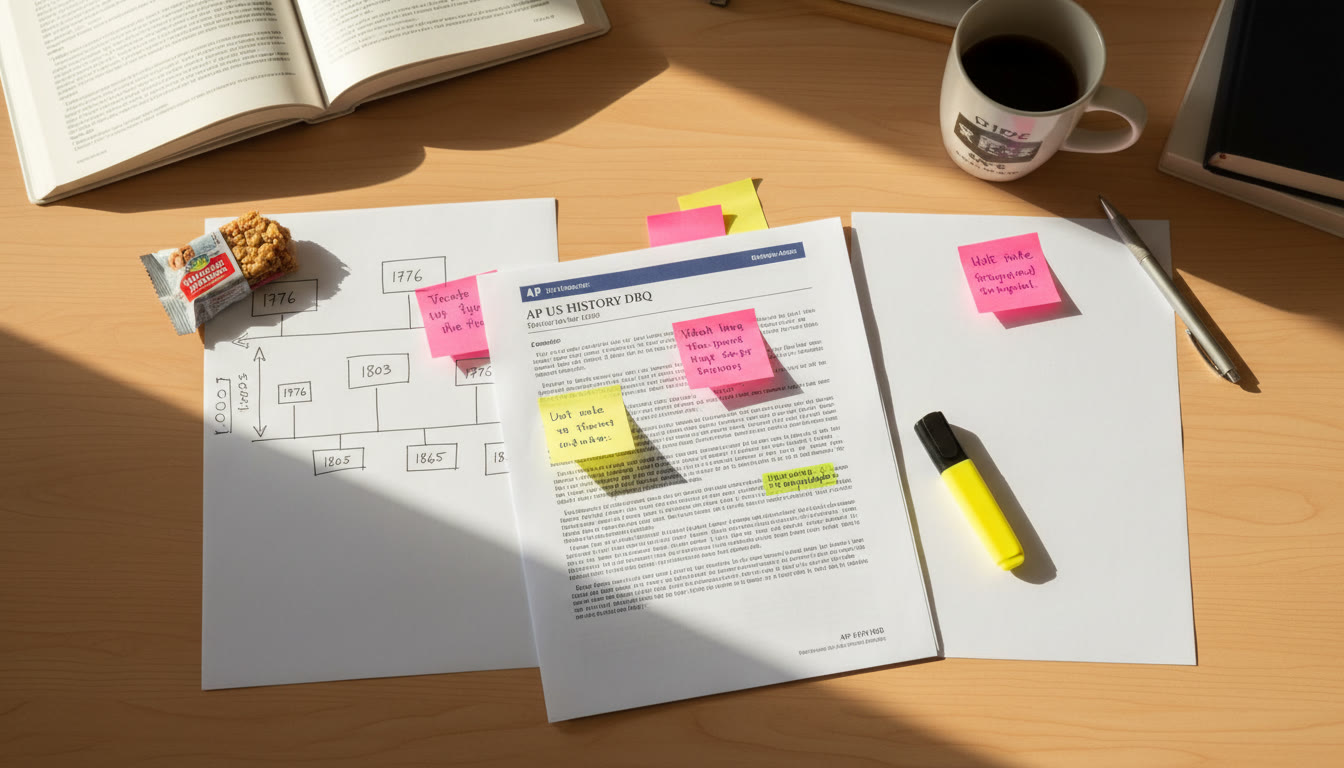Why Contextualization and Synthesis Matter (and Why They’re Often Overlooked)
If you’ve spent any time staring at a DBQ prompt, you already know two things: there’s a ticking clock, and there’s a stack of documents that feel like a different language. That panic is real — but the path from panic to confidence lives in two places: contextualization and synthesis. These aren’t just fancy rubric words. They’re the secret anchors that transform a collection of documents into a clear, persuasive historical argument.
Contextualization shows the reader you understand the broader setting — the political currents, economic pressures, social trends, or intellectual movements that make the documents make sense. Synthesis, meanwhile, is how you connect your argument to larger historical themes or other periods and ideas. When done well, they lift an essay from “good” to memorable: graders see a student who doesn’t just report evidence, but interprets it within a living, breathing past.

Start Strong: Turning the Prompt into a Contextualization Opportunity
The prompt is a gift. It tells you the time, the place, and the central issue — the scaffolding you need to build context immediately. Instead of trying to include every possible background fact, choose the 2–3 most relevant big-picture elements that shaped the documents’ creation and content.
How to pick them:
- Scan the dates and location: That narrows your field. If the prompt centers on Industrial Britain in the 1830s, you don’t need a deep dive into the American Civil War.
- Identify the dominant processes: Is it industrialization, imperial expansion, national revolution, or social reform? Anchor your context to that process.
- Choose significance: Explain why those conditions mattered for the issue in the prompt.
Example starter for a prompt about labor unrest in the 1830s:
“By the 1830s, rapid industrialization in urban Britain had reshaped work, family life, and political interests. As factories multiplied and artisanal crafts declined, new labor patterns and calls for political reform created a climate in which strikes and labor petitions became sharper tools for workers seeking economic and legal redress.”
Notice the difference between a collection of facts and a contextualization anchor: the sample ties facts to interpretation. That connection is what earns points.
Quick contextualization checklist
- Mention time and place immediately.
- Highlight 2–3 large-scale forces shaping events.
- Explain why those forces matter for the question at hand.
- Keep it concise: 2–4 sentences are usually enough.
Crafting Your Thesis as a Synthesis Anchor
Your thesis is not just a claim; it’s your essay’s anchor — and when you stitch it to a synthesis, it signals that you’re doing historical thinking at a higher level. Synthesis in DBQs doesn’t require you to name an unrelated event, but to explicitly connect your argument to a broader pattern, another period, or a different geographic context.
Types of synthesis you can use:
- Comparative synthesis: Connect the argument to a similar development in another region or era.
- Thematic synthesis: Link the claim to a long-term process (e.g., democratization, industrialization, imperialism).
- Continuity and change: Show how the prompt’s events are part of continuity or mark a turning point.
Thesis example (for the labor unrest prompt):
“Labor unrest in 1830s Britain reflected the disruptive social consequences of rapid industrialization, as workers used new collective actions to contest economic inequality — a pattern that echoes earlier artisan protests in the 18th century and anticipates later organized labor movements worldwide.”
That last clause is the synthesis anchor: it explicitly connects the topic to both a prior development and a broader global pattern. Even a short, clear synthesis line demonstrates the ability to place the specific argument in a wider historical conversation.
Organizing Evidence: Documents, Outside Information, and Analysis
The documents are your starting materials; outside information is what converts document analysis into an argument. The DBQ rubric rewards students who use documents to support a thesis and who also incorporate relevant outside knowledge — but it rewards analysis above mere listing. The goal is to reason: explain what a document shows, why the author wrote it, and how it fits into your thesis.
Smart ways to use documents
- Group documents thematically before you write. Create 2–4 idea clusters (economic motives, political rhetoric, popular reaction, legal change).
- For each document you cite, do two things: identify the content, and explain how it supports (or complicates) your thesis.
- Don’t paraphrase endlessly. Use short quotations or referenced ideas, then analyze context, perspective, or bias.
When to bring in outside information
Use outside knowledge to deepen explanation or to connect documents to broader facts not present in the sources. A single well-chosen example can be far more persuasive than several marginal facts. Be accurate and concise — graders value precise, relevant outside information tied directly to your point.
Rubric-Aligned Strategies: How to Earn Contextualization and Synthesis Points
Understanding what the rubric wants is half the battle. Contextualization and synthesis points are awarded when you demonstrate broad understanding and meaningful connections. Here’s how to align your writing to those expectations without sounding forced.
Contextualization strategy
- Put it before your thesis or in your opening paragraph. This establishes the frame immediately.
- Keep it purposeful: every sentence should clarify how the broader context shapes the documents or issue.
- Avoid generic statements. Name relevant institutions, movements, or events when possible.
Synthesis strategy
- Embed synthesis inside your thesis or save it as a concluding sentence that expands your argument outward.
- Make the connection explicit: use phrases like “this pattern resembles,” “this anticipates,” or “this contrasts with.”
- Prefer meaningful parallels (same causal mechanism, similar social outcomes) over superficial similarities.
Sample DBQ Outline: Putting Contextualization and Synthesis into Practice
Below is a compact example of how an essay might be organized. Imagine a DBQ about reform movements in mid-19th-century Europe.
| Section | What to Include | Purpose |
|---|---|---|
| Intro / Contextualization | Time/place, industrialization, political unrest, rising literacy and print culture | Frame the documents and show you understand macro forces |
| Thesis with Synthesis | Clear claim about causes and effects; link to later reforms or other regions | Anchor argument and signal broader thinking |
| Body Paragraph 1 | Use Documents A, C, E; bring in outside info on working-class agitation | Argue economic causes; analyze authors’ perspectives |
| Body Paragraph 2 | Use Documents B, D; outside info on political reform movements | Argue political catalysts and elite reactions |
| Body Paragraph 3 | Address counter-evidence; integrate Documents F, G; tie to social responses | Show complexity and nuance |
| Conclusion / Synthesis | Restate thesis succinctly; explicitly connect to broader theme (e.g., nation building or global labor movements) | Secure the synthesis point and leave the reader with a memorable insight |
Examples of Strong Contextualization and Synthesis Sentences
These short, modular sentences can be dropped into an introduction or conclusion to add immediate value.
- “By the early 19th century, the expansion of railways and factories had rearranged European economies in ways that made traditional social bonds fragile and new political demands urgent.” (Context)
- “This pattern of protest — local grievances organized through emerging mass media — foreshadows later national movements in the late 19th century.” (Synthesis)
- “While elites emphasized stability, growing literacy and urbanization gave popular movements a new reach and staying power.” (Context + link to documents)
- “Taken together, these documents reflect a larger global shift toward collective bargaining and organized labor that would define the next century.” (Synthesis)
Common Pitfalls and How to Avoid Them
Students often fall into predictable traps. The good news: these are easy to fix once you know what to watch for.
Pitfall: Overlong Context That Isn’t Tied to the Prompt
Fix: Keep context relevant. If your background doesn’t explain why the documents take the form they do, cut it.
Pitfall: Vague Synthesis
Fix: Make the connection explicit and specific. Don’t say “this is similar to other events” — say which events and why the comparison matters.
Pitfall: Document Dump
Fix: Use documents selectively and analytically. Each cited document should do work: support, complicate, or nuance your thesis.
Practice Drill: A 20-Minute Routine to Build Contextualization Muscle
Time yourself and try this short exercise three times a week. It trains you to spot big-picture anchors quickly — exactly what the DBQ reading period rewards.
- Pick a random AP history unit or a past DBQ prompt.
- Spend 5 minutes listing the three largest forces shaping that era (economic, political, social, cultural).
- Spend 10 minutes writing a concise contextualization paragraph and a thesis that includes a synthesis anchor.
- Spend 5 minutes reviewing and trimming: remove anything not directly tied to the prompt.
Do this repeatedly. The key is speed and relevance — you’re training your brain to convert big ideas into tight, exam-ready context.
Using Evidence Wisely: Balancing Documents and Outside Knowledge
Students often think more is better. But the DBQ rewards selection and explanation more than volume. Aim to use the documents to build the backbone of your argument and to use outside information as connective tissue that deepens and extends the claims.
How many documents should you use?
Quality beats quantity. Demonstrate that you’ve used multiple documents to support your thesis, and analyze the documents’ perspectives. A strong essay tends to use at least half the documents meaningfully, but what matters most is you weave them into a coherent argument.
Make authorship and audience matter
Interrogate who wrote each source and why. Explain how the creator’s position shaped what they said. Is the document a government proclamation, a laborer’s letter, a political cartoon, or a speech? These clues help you show critical thinking rather than mere summarizing.
Time Management: When to Build Context and When to Write Fast
Recommended timing for the DBQ portion (adapt for your pace):
- Reading and planning: 15 minutes — use this to build your contextualization and draft a thesis with synthesis.
- Writing: 45 minutes — aim for 4–6 clear paragraphs, integrating docs and outside info as you go.
- Reviewing: 5–10 minutes — check for clarity, add any brief synthesis if missing, and ensure document attributions are present.
Spending time up front on context and a focused thesis pays dividends: your paragraphs won’t wander, and your synthesis becomes a purposeful thread rather than an afterthought.
How Personalized Tutoring Can Sharpen These Skills
Mastering contextualization and synthesis is a skill that improves with targeted practice. That’s why many students benefit from personalized coaching: focused feedback helps you recognize weak or irrelevant context, tighten thesis sentences, and practice synthesis that feels natural rather than tacked on. Sparkl’s personalized tutoring offers 1-on-1 guidance, tailored study plans, expert tutors, and AI-driven insights to point out recurring errors and to build stronger DBQ muscles faster. If you’re struggling to apply these strategies under time pressure, guided practice can accelerate your progress.
Grading Lens: What AP Readers Look For
AP readers are trained to find evidence of historical thinking quickly. They look for an essay that does three main things:
- Positions itself in history (contextualization) so the documents aren’t floating facts but pieces of a larger story.
- Uses documents and outside information to support a clear, defensible thesis.
- Shows synthesis — connecting the argument to bigger themes or comparing it meaningfully to other historical developments.
Remember: clarity and directness are persuasive. A sharp, well-supported argument will always outscore a long, unfocused one.
Final Checklist Before You Submit
- Is your contextualization concise, specific, and tied to the prompt?
- Does your thesis answer the prompt clearly and take a defensible position?
- Is there an explicit synthesis line, either in the thesis or conclusion?
- Have you used documents analytically (author, purpose, audience, context) rather than merely summarizing?
- Have you added at least a few pieces of accurate outside information that strengthen your analysis?
- Is your writing organized, with transitions and topic sentences that show the flow of your argument?

Parting Thought: Make Context and Synthesis Part of Your Storytelling
Historical writing is storytelling with evidence. Contextualization gives your story its setting; synthesis connects it to other stories that matter. Approach the DBQ as an invitation to join an ongoing conversation about the past — then use the documents and your knowledge to speak clearly and confidently. With regular practice, targeted feedback, and the right strategies, contextualization and synthesis become second nature, not last-minute add-ons.
Whether you practice on your own, with peers, or through tailored help like Sparkl’s 1-on-1 tutoring and study plans, focus on precision: precise context, precise thesis, precise synthesis. Those precisions add up into essays that not only answer the prompt but also show you thinking like a historian. Do that, and you’ll be more than prepared — you’ll be memorable.
Quick Reference: One-Page DBQ Cheat Sheet
| Task | What to Include | Approx. Time |
|---|---|---|
| Read Prompt | Note dates, places, key verbs | 2–3 min |
| Contextualize | 2–3 big-picture forces, 2–4 sentences | 5 min |
| Thesis + Synthesis | Clear claim + explicit connection outward | 3–5 min |
| Plan Paragraphs | Group docs, plan outside info | 3–4 min |
| Write | 4–6 paragraphs; analyze docs and use outside info | 40–45 min |
| Review | Add brief synthesis if missing, check clarity | 5–10 min |
Ready to Practice?
Pick a past DBQ, set a timer, and follow the cheat sheet. Then swap essays with a classmate or get targeted feedback to find recurring weaknesses. Over time, contextualization and synthesis will shift from being things you try to remember to the natural way you think about history — and that’s when your DBQ scores will reflect the work you’ve put in.
Good luck — and remember: an argument framed with accurate context and a thoughtful synthesis is an argument that graders remember. Practice strategically, and make your DBQ voice unmistakably yours.


















No Comments
Leave a comment Cancel